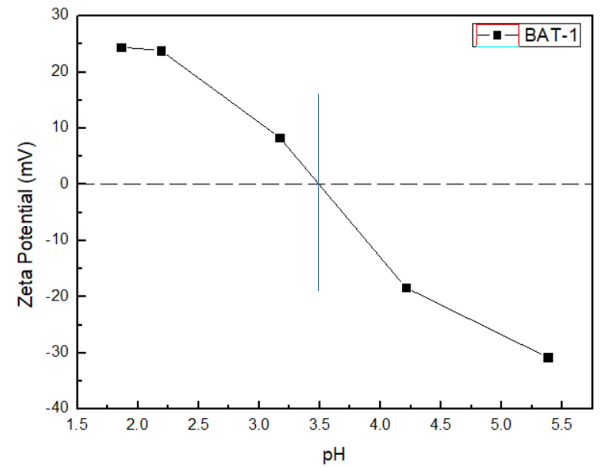Zeta potential is reliant on a particle surface’s chemical composition as well as the medium environment, such as pH and salt concentration. As a result, a particle system can display various zeta potentials at different pH levels.
Amphoteric materials typically carry more positive charges in the low pH range and more negative charges in the high pH range. The isoelectric point (IEP) describes the pH level at which particles carry zero net electrical charge and consequently have the lowest electrostatic repulsive force and stability.
The effect of pH on the zeta potential may be interpreted from various perspectives. Firstly, the pH impacts the dissociation equilibrium of the groups on the surface of the particle. Secondly, both the [H]+ and [OH]- concentrations of the solution influence the absorption efficiency of these ions on the particle's surface.
Finally, adding a base or acid during titration alters the ionic strength of the dispersion. All the above factors should be considered when interpreting the titration curves. This article presents an experiment concerning measurements of the zeta potentials of titanium dioxide (TiO2) at various pH levels.
Principle
Electrophoretic light scattering (ELS) is employed to measure the zeta potential. This method involves a laser beam irradiating the sample with the scattered light being detected at a forward angle of 12°.
The sample solution or suspension is exposed to an electric field, which is applied to the ends of the sample cell. This causes electrophoretic movement of the sample’s charged particles.
Due to the Doppler effect, the frequency of the scattered light shifts in comparison to the incident light. PALS analysis is utilized to determine the phase shift of the scattered light signals.
The velocity of electrophoretic movement per unit of the electric field, represented by the electrophoretic mobility µ, is acquired using the phase plot. The electrophoretic mobility µ, as well as its zeta potential ζ, can be determined using Henry’s equation as follows:

Here, ε0 denotes the solvent dielectric constant in the vacuum, while εγ denotes the relative dielectric constant. The solvent viscosity is denoted by η, the Henry function is denoted by f(Κα), the reciprocal Debye length is denoted by K, and lastly, the particle radius is denoted by α.
Κα represents the ratio between the thickness of the double layer and the particle radius.
The BeNano 90 Zeta from Bettersize Instruments was employed to measure the zeta potentials in this experiment.
Experimental
The TiO2 powder was dispersed in pure water and subsequently stirred with a magnetic stirrer for 15 minutes.
The initial pH level is 5.4, and the corresponding zeta potential is negative. The titration is automatically carried out from pH 5.4 to 2 with HCl titrant using the BAT-1 autotitrator, and the tolerance and pH interval are set to 0.2 and 1, respectively.
The BeNano analyzer is employed to measure the zeta potentials with the folded capillary cell. The analyzer’s built-in temperature control system is utilized to maintain the default temperature of 25 ℃ ± 0.1 ℃. One zeta potential measurement was obtained at each target pH.
Results

Figure 1. The zeta potential curve at different pH. Image Credit: Bettersize Instruments Ltd
Figure 1 presents the zeta potentials of TiO2, which can be seen to be positive in the low pH range. This suggests that there are many positive charges on the particles. As the pH level increases, the zeta potential tends to 0 mV, and the dispersion reaches the IEP at pH 3.5.
As the pH increases, the particles start to carry negative charges, and the magnitude of zeta potential progressively increases.
When more charges (positive or negative) are present on the particles, the zeta potentials of the dispersion have greater magnitudes, indicating that the system is more stable and aggregates are less likely to form.
Conclusion
Employing the BeNano with PALS (phase analysis light scattering) facilitates the effective measurement of a sample with low electrophoretic mobility. Accurate zeta potentials may be acquired even within the potential range of ± 10 mV, which is highly important for confirmation of the IEP of the system.
Using the BeNano with BAT-1 substantially increases the ease of use, enhancing the titration efficiency and minimizing workload.
Acknowledgments
Produced from materials originally authored by Jing Cao and Hui Ning from the Application Research Lab at Bettersize Instruments Ltd.

This information has been sourced, reviewed and adapted from materials provided by Bettersize Instruments Ltd.
For more information on this source, please visit Bettersize Instruments Ltd.
